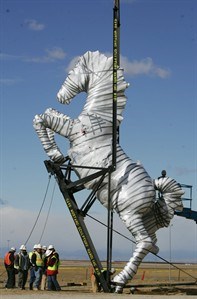
FILE - Construction workers install a mustang sculpture at Denver International Airport on Monday, Feb. 11, 2008. The sculpture, over 30 feet tall, is by artist, Luis Jimenez, of Hondo, N.M., who was killed in 2006 when a segment of the sculpture fell on him as it was being hoisted. New Mexico preservation officials are pushing for the home and studios of Jimenez to be added to the National Register of Historic Properties. Jimenez was a successful but often controversial sculptor whose work has been displayed at the Smithsonian and the Museum of Modern Art. (AP Photo/Rocky Mountain News, Chris Schneider) **DENVER POST OUT**
Republished October 23, 2014 - 12:17 PM
Original Publication Date October 23, 2014 - 9:30 AM
ALBUQUERQUE, N.M. - Artist Luis Jimenez is credited with helping transform the definition of public art in the U.S. with his larger-than-life, debate-provoking fiberglass sculptures.
Now, state preservation officials are pushing to get the home and studios of the late artist in southern New Mexico on the National Register of Historic Places after the sites were added to the state's list of significant cultural properties earlier this week.
"Even though his work is relatively recent, there's really a consensus among art historians and museum curators and art critics on his importance in late 20th century American art," said Steven Moffson, state and national register co-ordinator with the New Mexico Historic Preservation Division.
New Mexico has forwarded the nomination to the National Park Service. A decision is expected before the end of the year.
Known for his colorful and massive sculptures of Mexican cowboys, fiesta dancers and wild mustangs, Jimenez helped open the door for other Mexican-American artists. He was sought out by dozens of cities to create public art and now he's represented everywhere from a busy walkway at the University of New Mexico to the steps of the Smithsonian American Art Museum in Washington, D.C.
Born the son of an award-winning craftsman, Jimenez helped fabricate and paint the neon signs his father's shop sold to businesses throughout the U.S. But it was the trips he took to Mexico City with his family when he was young that started his artistic wheels spinning.
"He was always amazed how art was accessible to everyone," said his widow, Susan Jimenez. "That really helped, I think, to form his opinion of art, that it doesn't have to be locked up in a museum. It can be on the street and it can influence people in a positive way."
Jimenez found success with the New York gallery scene during the 1960s and became a master at blending his Mexican-American heritage with the political and social issues of the day.
But it wasn't until he moved back to the Southwest that he began creating his large sculptures. More than 40 cities have commissioned his art.
Most of those works were drawn, sculpted with clay and eventually moulded into large fiberglass forms at his studios in the village of Hondo, at the edge of the Sierra Blanca and Capitan mountain ranges.
Jimenez and his wife converted a 1902 adobe school house and New Deal-era gymnasium into their home. Two miles down the road was a separate property known as the Apple Shed, where he applied finishes to his monumental works.
During his more than 20 years living and working in Hondo, Jimenez created nearly all his public sculptures in the studios, including "Sodbuster," ''Southwest Pieta," ''Border Crossing" and his largest and last piece, "Mustang," a blue horse with fiery eyes that sits outside Denver International Airport. A portion of that sculpture fell in his studio and killed him in 2006.
Susan Jimenez has left the studios much as they were when Jimenez was alive.
"You walk through and see hundreds of paint cans and all the equipment for spray-painting and casting fiberglass moulds. You see all the raw rolls of fiberglass. Even drums of raw clay are still there," Moffson said.
That's rare, Moffson said, because most historic and cultural properties date back several decades, if not centuries, and much of the materials and stories that were once inside the bricks and mortar are long gone.
Jimenez taught at the University of Arizona and the University of Houston, mentoring many young artists along the way. Despite his rejections of labels such as Mexican-American, Chicano and Hispanic, his wife said he was proud of his heritage and liked to focus on depicting daily life.
"My working-class roots have a lot to do with it," Luis Jimenez said once during an interview. "I want to create a popular art that ordinary people can relate to as well as people who have degrees in art."
News from © The Associated Press, 2014